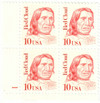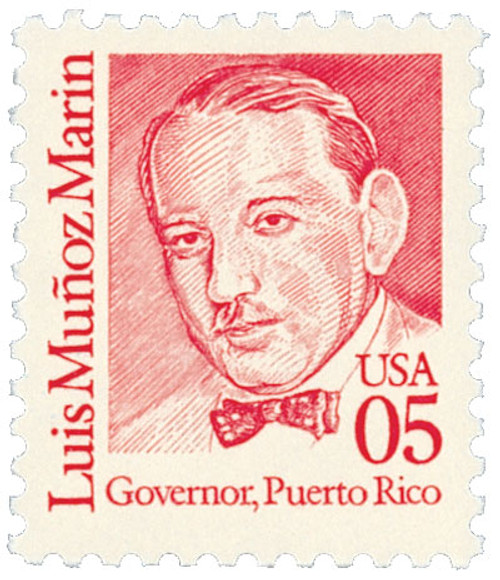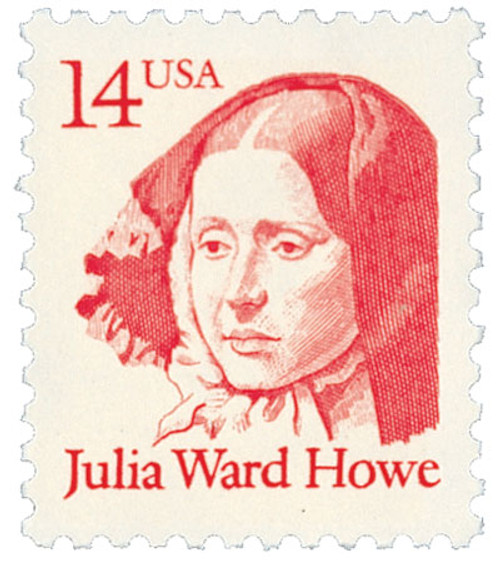
# 2175 - 1987 10c Great Americans: Red Cloud
U.S. #2175
1987 10¢ Red Cloud
Great Americans
- 38th stamp in Great Americans Series
- Third Native American honored in Great Americans Series
- Paid the first-class rate for letters of nonstandard size
Stamp Category: Definitive
Series: Great Americans
Value: 10¢, rate for first-class nonstandard dimension letters
First Day of Issue: August 15, 1987
First Day City: Red Cloud, Nebraska
Quantity Issued: 59,700,000
Printed by: Bureau of Engraving and Printing
Printing Method: Engraved
Format: Panes of 100 in sheets of 800
Perforations: 11
Color: Lake
Why the stamp was issued: To replace the 1984 10¢ Richard Russell stamp. Between February 17, 1985 and January 1, 1995, 10¢ covered the surcharge for first-class letters weighing an ounce or less measuring more than 11 1/2 inches wide, more than 6 1/8 inches tall, or more than ¼ inch thick.
About the stamp design: Robert Anderson created his artwork for this stamp based on several photos of Red Cloud in the collections of the Smithsonian. This was Anderson’s fourth design for the Great Americans Series.
First Day City: The First Day ceremony for this stamp was held in Red Cloud, Nebraska, a town named after the Sioux chief.
Unusual fact about this stamp: Error varieties of this stamp include dull gum, tagging omitted, prephosphored coated paper with surface tagging showing a solid appearance, prephosphored uncoated paper with embedded tagging showing a mottled appearance and shiny gum, phosphored uncoated paper with embedded tagging showing a mottled appearance with shiny gum, and all color omitted.
About the Great Americans Series: The Great Americans Series was created to replace the Americana Series. The new series would be characterized by a standard definitive size, simple design, and monochromatic colors.
This simple design included a portrait, “USA,” the denomination, the person’s name, and in some cases, their occupation or reason for recognition. The first stamp in the new series was issued on December 27, 1980. It honored Sequoyah and fulfilled the new international postcard rate that would go into effect in January 1981.
The Great Americans Series would honor a wider range of people than the previous Prominent Americans and Liberty Series. While those series mainly honored presidents and politicians, the Great Americans Series featured people from many fields and ethnicities. They were individuals who were leaders in education, the military, literature, the arts, and human and civil rights. Plus, while the previous series only honored a few women, the Great Americans featured 15 women. This was also the first definitive series to honor Native Americans, with five stamps.
The Bureau of Engraving and Printing (BEP) produced most of the stamps, but private firms printed some. Several stamps saw multiple printings. The result was many different varieties, with tagging being the key to understanding them. Though there were also differences in perforations, gum, paper, and ink color.
The final stamp in the series was issued on July 17, 1999, honoring Justin S. Morrill. Spanning 20 years, the Great Americans was the longest-running US definitive series. It was also the largest series of face-different stamps, with a total of 63.
Click here for all the individual stamps and click here for the complete series.
History the stamp represents: Red Cloud’s birth date is unknown, but it’s believed he was born in 1822 near modern-day North Platte, Nebraska. Details concerning Red Cloud’s early life are unclear. It is known that, in the tradition of the Lakota, his uncle, Old Chief Smoke, mentored Red Cloud. After Red Cloud’s parents died, Old Chief Smoke took him in. Red Cloud went to war quite young, often against the Pawnee, Crow, Utes, and Shoshones. His leadership during these conflicts earned Red Cloud great prominence among his people.
Gold was discovered in Montana during the 1860s. White settlers soon began to travel the Bozeman Trail, which went through Lakota territory, to reach these gold fields. Fearful of white incursions into his people’s lands, Red Cloud frequently attacked these travelers. In response, the United States Army began to construct forts along the Bozeman Trail to provide protection. Fort Phil Kearny and Fort Reno were built in Wyoming, and Fort C.F. Smith was established in Montana. Red Cloud and his men were determined to stop the expansion into their territory.
Starting in 1866, Red Cloud led the most successful war against the US ever waged by an Indian nation, Red Cloud’s War. In December 1866, Lieutenant Colonel William Fetterman and 80 men were near Fort Phil Kearny in Wyoming when over 1,000 warriors attacked. All the soldiers were killed. The forts of the Bozeman Trail were kept under constant siege for two years. Red Cloud achieved victory in 1868, when the US government agreed to the Fort Laramie Treaty. This remarkable treaty resulted in the abandonment of the Bozeman forts and guaranteed the Lakota their lands in South Dakota (including the Black Hills), Montana, and Wyoming. Many historians believe Red Cloud is the only Native American to ever win a war against the United States.
In 1874, General Custer broke the treaty. Red Cloud chose not to fight along with Crazy Horse and Sitting Bull, however. With the military defeat of the Lakota, Red Cloud worked with the US government to secure better treatment of his people instead. Red Cloud and his people moved to Pine Ridge Reservation. The chief made sure his people received food and supplies. He opposed the 1887 Dawes Act, which divided the land into tracts and sold the surplus to white settlers. Red Cloud once said, “They made us many promises, more than I can remember. But they kept but one – They promised to take our land… and they took it.”
Red Cloud died on Pine Ridge Reservation on December 10, 1909. He was buried in a cemetery that now bears his name. During his lifetime, he was the most photographed Native American of the 19th century, with 128 known photos. The town of Red Cloud, Nebraska was named in his honor and he was inducted into the Nebraska Hall of Fame.
U.S. #2175
1987 10¢ Red Cloud
Great Americans
- 38th stamp in Great Americans Series
- Third Native American honored in Great Americans Series
- Paid the first-class rate for letters of nonstandard size
Stamp Category: Definitive
Series: Great Americans
Value: 10¢, rate for first-class nonstandard dimension letters
First Day of Issue: August 15, 1987
First Day City: Red Cloud, Nebraska
Quantity Issued: 59,700,000
Printed by: Bureau of Engraving and Printing
Printing Method: Engraved
Format: Panes of 100 in sheets of 800
Perforations: 11
Color: Lake
Why the stamp was issued: To replace the 1984 10¢ Richard Russell stamp. Between February 17, 1985 and January 1, 1995, 10¢ covered the surcharge for first-class letters weighing an ounce or less measuring more than 11 1/2 inches wide, more than 6 1/8 inches tall, or more than ¼ inch thick.
About the stamp design: Robert Anderson created his artwork for this stamp based on several photos of Red Cloud in the collections of the Smithsonian. This was Anderson’s fourth design for the Great Americans Series.
First Day City: The First Day ceremony for this stamp was held in Red Cloud, Nebraska, a town named after the Sioux chief.
Unusual fact about this stamp: Error varieties of this stamp include dull gum, tagging omitted, prephosphored coated paper with surface tagging showing a solid appearance, prephosphored uncoated paper with embedded tagging showing a mottled appearance and shiny gum, phosphored uncoated paper with embedded tagging showing a mottled appearance with shiny gum, and all color omitted.
About the Great Americans Series: The Great Americans Series was created to replace the Americana Series. The new series would be characterized by a standard definitive size, simple design, and monochromatic colors.
This simple design included a portrait, “USA,” the denomination, the person’s name, and in some cases, their occupation or reason for recognition. The first stamp in the new series was issued on December 27, 1980. It honored Sequoyah and fulfilled the new international postcard rate that would go into effect in January 1981.
The Great Americans Series would honor a wider range of people than the previous Prominent Americans and Liberty Series. While those series mainly honored presidents and politicians, the Great Americans Series featured people from many fields and ethnicities. They were individuals who were leaders in education, the military, literature, the arts, and human and civil rights. Plus, while the previous series only honored a few women, the Great Americans featured 15 women. This was also the first definitive series to honor Native Americans, with five stamps.
The Bureau of Engraving and Printing (BEP) produced most of the stamps, but private firms printed some. Several stamps saw multiple printings. The result was many different varieties, with tagging being the key to understanding them. Though there were also differences in perforations, gum, paper, and ink color.
The final stamp in the series was issued on July 17, 1999, honoring Justin S. Morrill. Spanning 20 years, the Great Americans was the longest-running US definitive series. It was also the largest series of face-different stamps, with a total of 63.
Click here for all the individual stamps and click here for the complete series.
History the stamp represents: Red Cloud’s birth date is unknown, but it’s believed he was born in 1822 near modern-day North Platte, Nebraska. Details concerning Red Cloud’s early life are unclear. It is known that, in the tradition of the Lakota, his uncle, Old Chief Smoke, mentored Red Cloud. After Red Cloud’s parents died, Old Chief Smoke took him in. Red Cloud went to war quite young, often against the Pawnee, Crow, Utes, and Shoshones. His leadership during these conflicts earned Red Cloud great prominence among his people.
Gold was discovered in Montana during the 1860s. White settlers soon began to travel the Bozeman Trail, which went through Lakota territory, to reach these gold fields. Fearful of white incursions into his people’s lands, Red Cloud frequently attacked these travelers. In response, the United States Army began to construct forts along the Bozeman Trail to provide protection. Fort Phil Kearny and Fort Reno were built in Wyoming, and Fort C.F. Smith was established in Montana. Red Cloud and his men were determined to stop the expansion into their territory.
Starting in 1866, Red Cloud led the most successful war against the US ever waged by an Indian nation, Red Cloud’s War. In December 1866, Lieutenant Colonel William Fetterman and 80 men were near Fort Phil Kearny in Wyoming when over 1,000 warriors attacked. All the soldiers were killed. The forts of the Bozeman Trail were kept under constant siege for two years. Red Cloud achieved victory in 1868, when the US government agreed to the Fort Laramie Treaty. This remarkable treaty resulted in the abandonment of the Bozeman forts and guaranteed the Lakota their lands in South Dakota (including the Black Hills), Montana, and Wyoming. Many historians believe Red Cloud is the only Native American to ever win a war against the United States.
In 1874, General Custer broke the treaty. Red Cloud chose not to fight along with Crazy Horse and Sitting Bull, however. With the military defeat of the Lakota, Red Cloud worked with the US government to secure better treatment of his people instead. Red Cloud and his people moved to Pine Ridge Reservation. The chief made sure his people received food and supplies. He opposed the 1887 Dawes Act, which divided the land into tracts and sold the surplus to white settlers. Red Cloud once said, “They made us many promises, more than I can remember. But they kept but one – They promised to take our land… and they took it.”
Red Cloud died on Pine Ridge Reservation on December 10, 1909. He was buried in a cemetery that now bears his name. During his lifetime, he was the most photographed Native American of the 19th century, with 128 known photos. The town of Red Cloud, Nebraska was named in his honor and he was inducted into the Nebraska Hall of Fame.


















